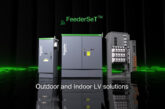
Paul Collins, Technical and Training Manager for Hager answers some of the common questions put to the ‘Regs Live’ team to help contractors get to grips with the new regulatory landscape.
To help electricians to prepare for the changes to the 18th Edition, our team of experts has been out meeting electrical contractors across the UK as part of the innovative ‘Regs Live’ campaign.
Following a number of recent trade shows, including ELEX, we’ve identified some of the most commonly asked questions from contractors:
Do I have to fit surge protection?
Surge protection devices are strongly recommended for installations that are exposed to transients and to protect sensitive and expensive electrical equipment such as TVs, washing machines, PCs, alarms etc.
Does it matter where in the board I fit it?
Yes. It should be as close to the incomer as possible, with the shortest, straightest cable links between the circuit protection device and the surge protection device.
What does a surge protection kit consist of?
A Hager surge protection kit consists of a circuit protection device, surge protection device and all relevant busbars and cables.
Why do I need a ‘C’ curve MCB with the kit?
To reduce the risk of the breaker tripping and removing the surge protection device from the electrical installation. To allow the maximum energy through to the surge protection device without tripping the device.
Where do I install an Arc Fault Detection Device (AFDD)?
In the consumer unit/distribution board at the origin of AC final circuits, as per regulation 532.6
What are the potential hazards that AFDDs protect against?
Arc faults can be caused by all types of cable and insulation damage, including a kink or break in a cable, cable wear due to frequent use, cable damage resulting from drilling or construction work, incorrect wire stripping, incorrect bending radii, loose screwed connections, defective wall plugs, and rodents biting cables. An AFDD will trip the circuit when a potentially hazardous arc occurs, eliminating the resulting fire hazard.
How are they different to a miniature circuit breaker (MCB)?
An AFDD is activated by both series and parallel arc faults. Unlike circuit breakers or RCDs, an AFDD does not have an electromechanical trigger, but utilises electronic technology to analyse the signature (waveform) of an arc. It reliably differentiates between an arc fault and the signature (waveform) in normal switching and control events, preventing false tripping.
For more information on the 18th Edition and how Hager is on hand to support electrical contractors visit: www.hager.co.uk/18thEdition








